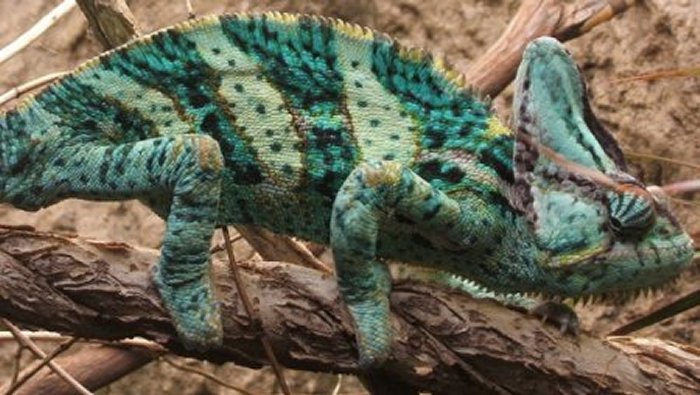Why Do Chameleons Change Colors In Unusual Ways?
MessageToEagle.com – Chameleons change colors in unusual ways when they interact with other chameleons and it doesn’t happen without a reason.
Native to Saudi Arabia and Yemen, veiled chameleons (Chameleon calyptratus) change colors when they convey different types of information during important social interactions.
When male chameleons challenge each other for territory or a female, their coloring becomes brighter and much more intense.
Males that display brighter stripes when they are aggressive are more likely to approach their opponent, and those that achieve brighter head colors are more likely to win fights.
Also, how quickly their heads change color is an important predictor of which chameleon will win a skirmish.
“We found that the stripes, which are most apparent when chameleons display their bodies laterally to their opponents, predict the likelihood that a chameleon will follow up with an actual approach,” said Russell Ligon, a doctoral candidate in ASU’s School of Life Sciences.

“In addition, head coloration — specifically brightness and speed of color change — predicted which was lizard was going to win.”
Researchers studied the distance, maximum brightness and speed of color change of 28 different patches across the chameleons’ bodies.
Chameleons typically have resting colors that range from brown to green, with hints of yellow, but each chameleon has unique markings.
See also:
Three-Eyed Tuatara Is The Closest Living Relative To The Dinosaurs
Ilha de Queimada Grande: The Snake Island Is World’s Deadliest Island
During a contest, the lizards show bright yellows, oranges, greens and turquoises. Interestingly, when the chameleons showed-off their stripes from a distance and followed that display with a “head-on” approach before combat, the important color signals on the striped parts of the body and head were accentuated.
“By using bright color signals and drastically changing their physical appearance, the chameleons’ bodies become almost like a billboard — the winner of a fight is often decided before they actually make physical contact,” Ligon said.
“The winner is the one that causes its opponent to retreat. While sometimes they do engage in physical combat, these contests are very short — five to 15 seconds. More often than not, their color displays end the contest before they even get started.”
MessageToEagle.com
Related Posts
-
 The Eiffel Tower Housed A Scientific Laboratory
No Comments | Feb 8, 2016
The Eiffel Tower Housed A Scientific Laboratory
No Comments | Feb 8, 2016 -
 Algonquin People And The Myth Of The Medicine Woman In The Moon
No Comments | Feb 1, 2016
Algonquin People And The Myth Of The Medicine Woman In The Moon
No Comments | Feb 1, 2016 -
 Catequil – Inca God Of Thunder And Lightning Who Predicted The Future And Was Cultural Hero Of Inca People
No Comments | Dec 18, 2023
Catequil – Inca God Of Thunder And Lightning Who Predicted The Future And Was Cultural Hero Of Inca People
No Comments | Dec 18, 2023 -
 Shamash: Mesopotamian God Of Sun, Truth, Justice And Healing
No Comments | Jan 11, 2016
Shamash: Mesopotamian God Of Sun, Truth, Justice And Healing
No Comments | Jan 11, 2016 -
 Human Noise Has A Negative Effect On Plants
No Comments | Feb 23, 2014
Human Noise Has A Negative Effect On Plants
No Comments | Feb 23, 2014 -
 People Can Float In The Dead Sea
No Comments | Jan 25, 2016
People Can Float In The Dead Sea
No Comments | Jan 25, 2016 -
 Matrix Dilemma – Do Humans Live In The Ultimate Computer Game Of The Superior Ones?
No Comments | May 30, 2013
Matrix Dilemma – Do Humans Live In The Ultimate Computer Game Of The Superior Ones?
No Comments | May 30, 2013 -
 Network Of Miles-Long Blood Vessels In Human Body
No Comments | Mar 30, 2016
Network Of Miles-Long Blood Vessels In Human Body
No Comments | Mar 30, 2016 -
 Prehistoric Predator? Artificial Intelligence Says No
No Comments | Nov 17, 2022
Prehistoric Predator? Artificial Intelligence Says No
No Comments | Nov 17, 2022 -
 Monster Black Holes 10 Billion Times Greater Than The Sun
No Comments | May 28, 2016
Monster Black Holes 10 Billion Times Greater Than The Sun
No Comments | May 28, 2016
